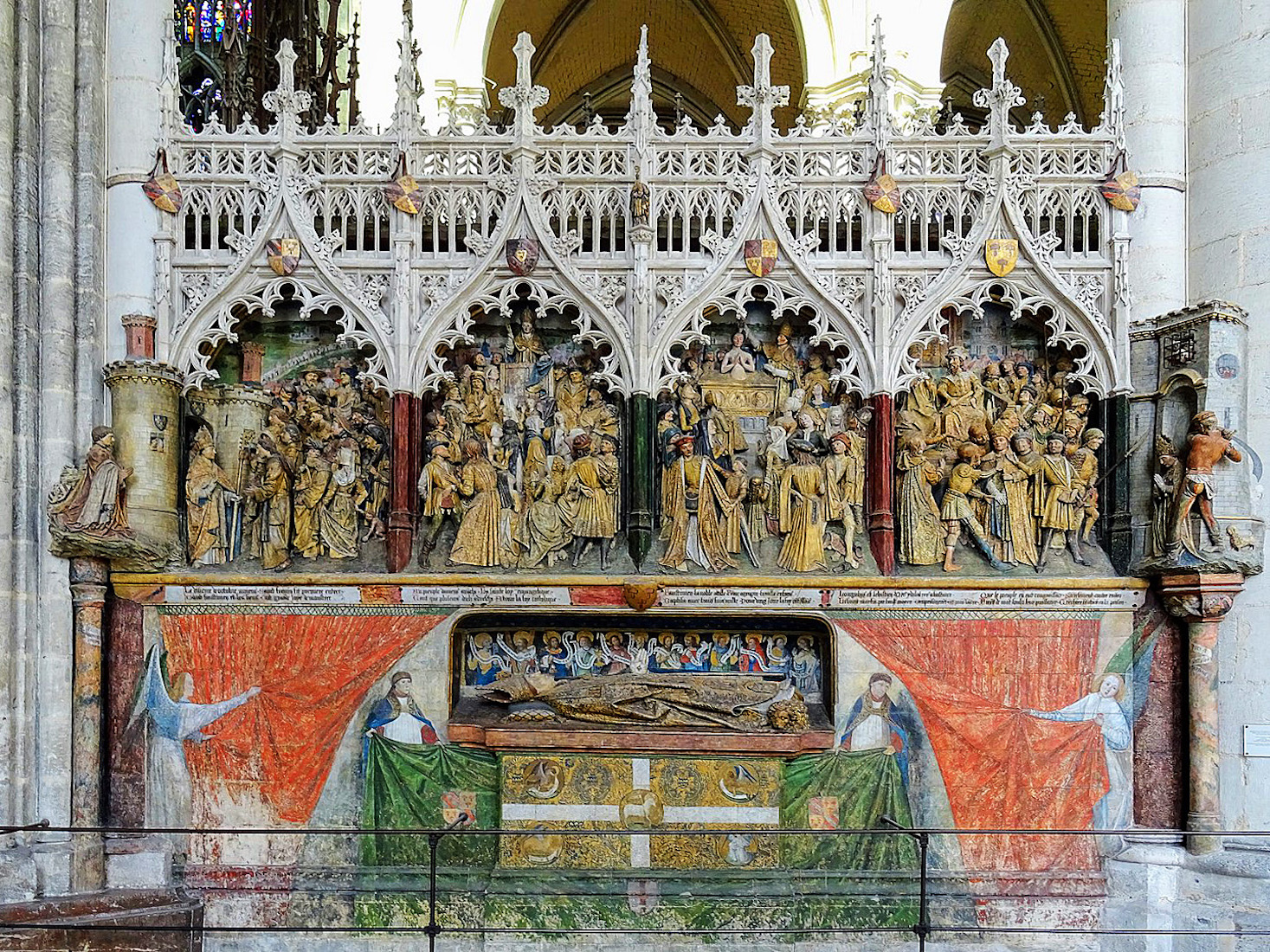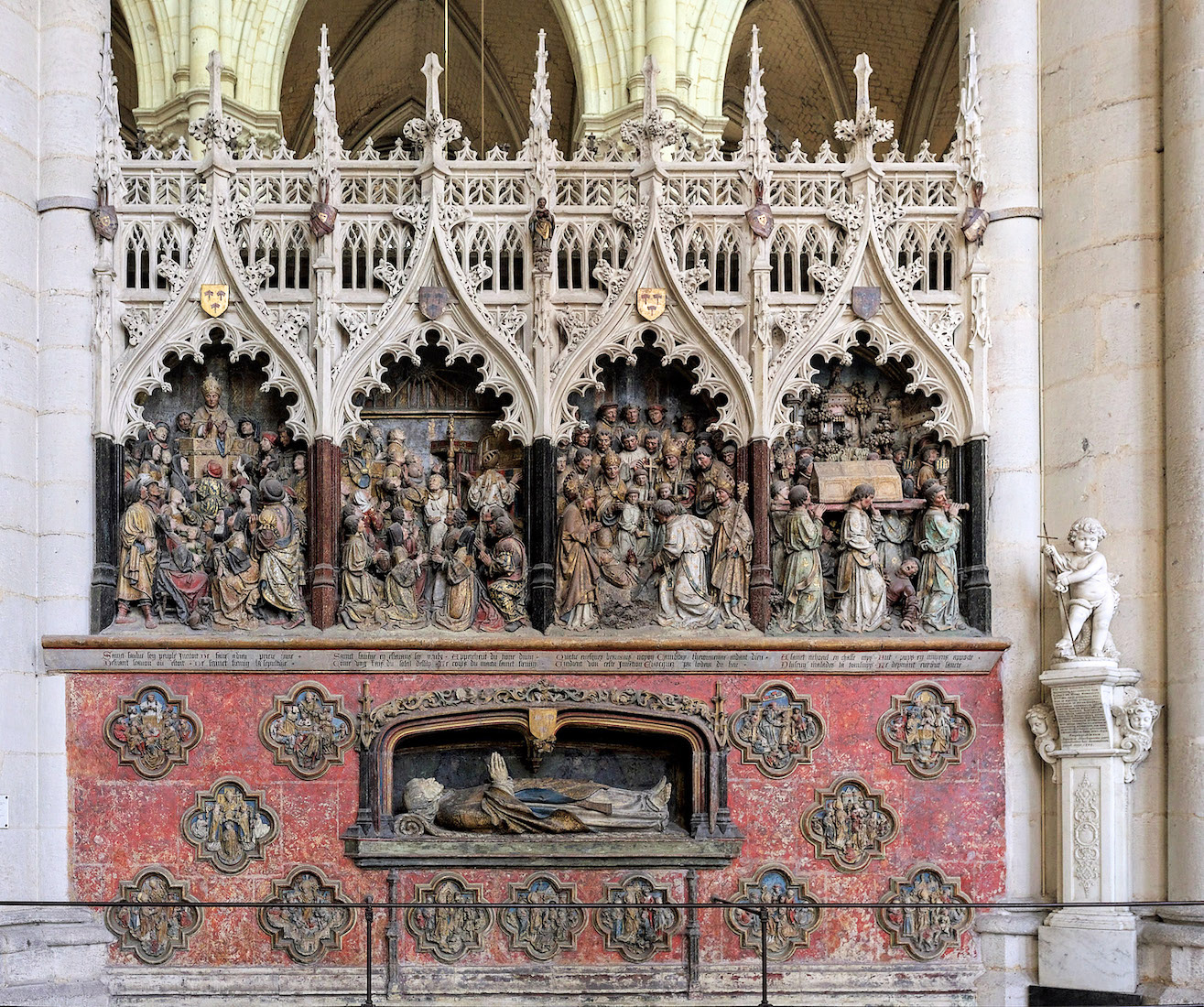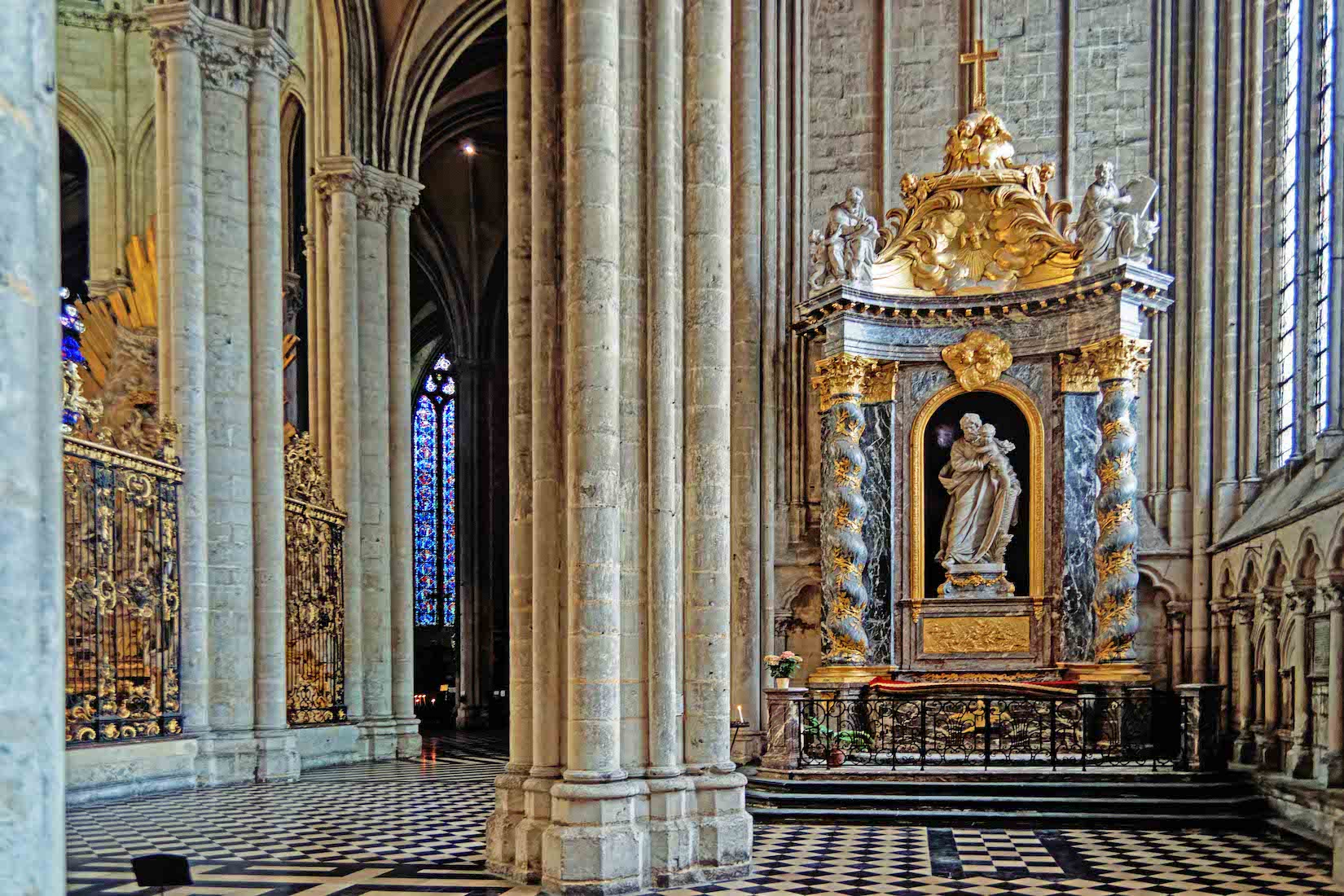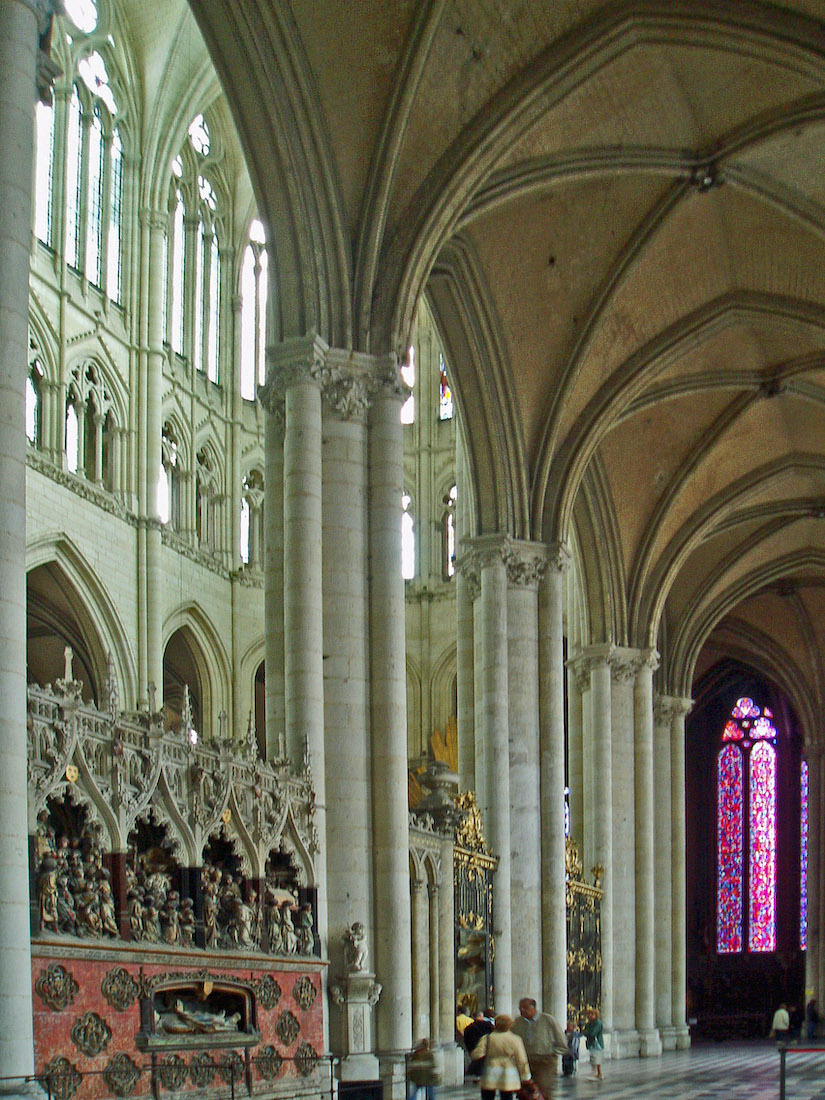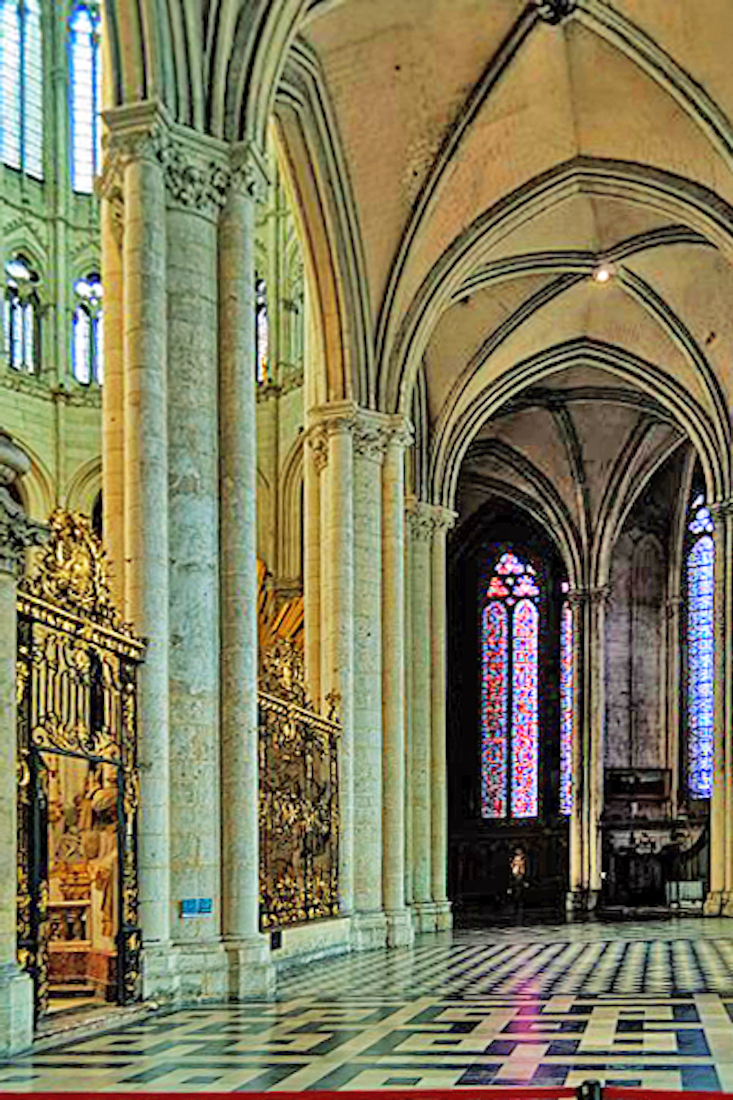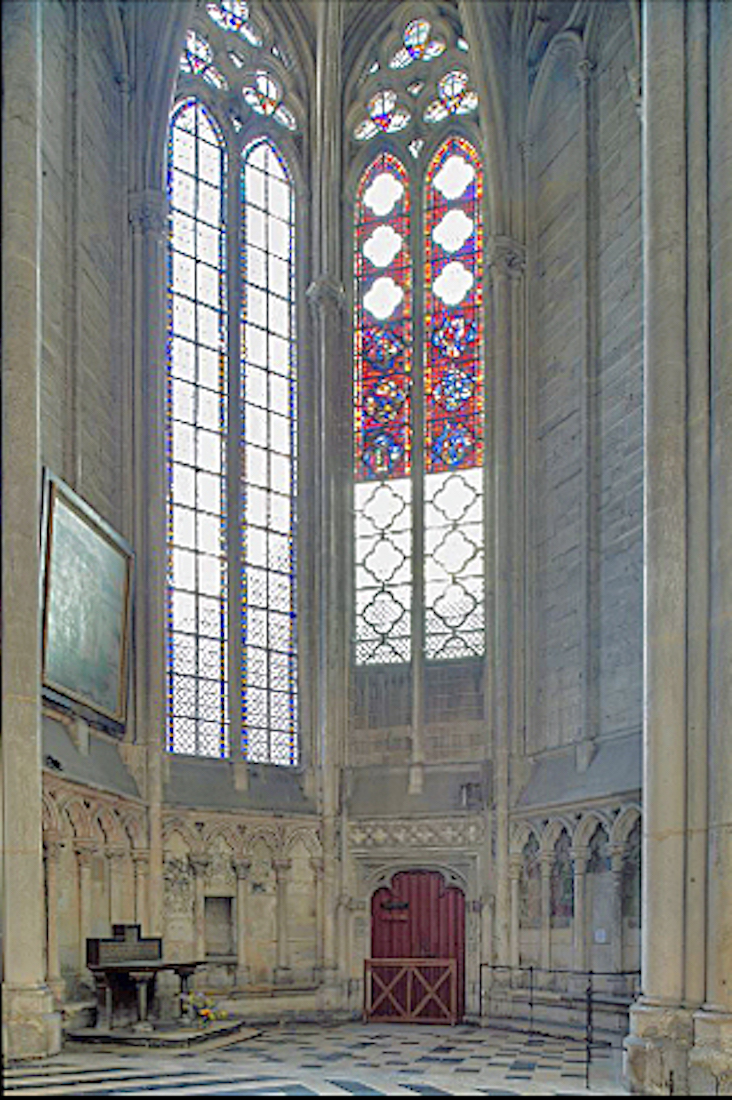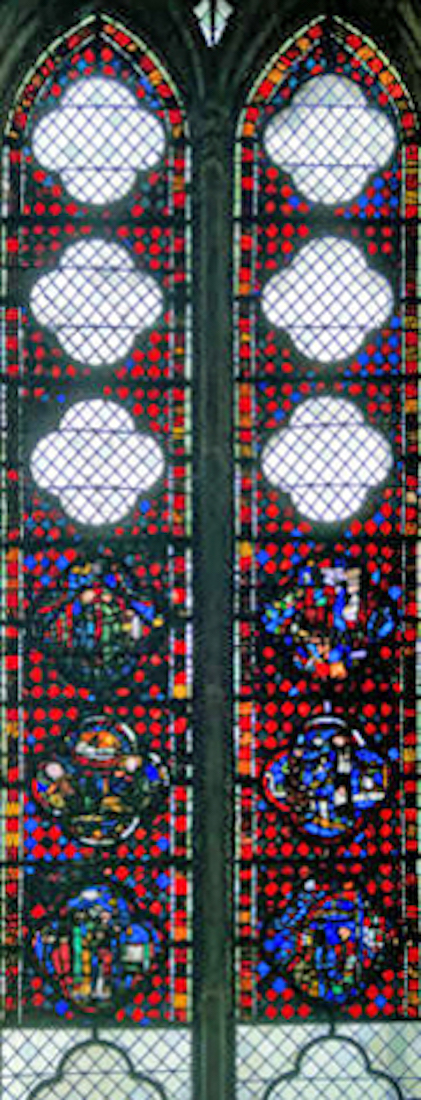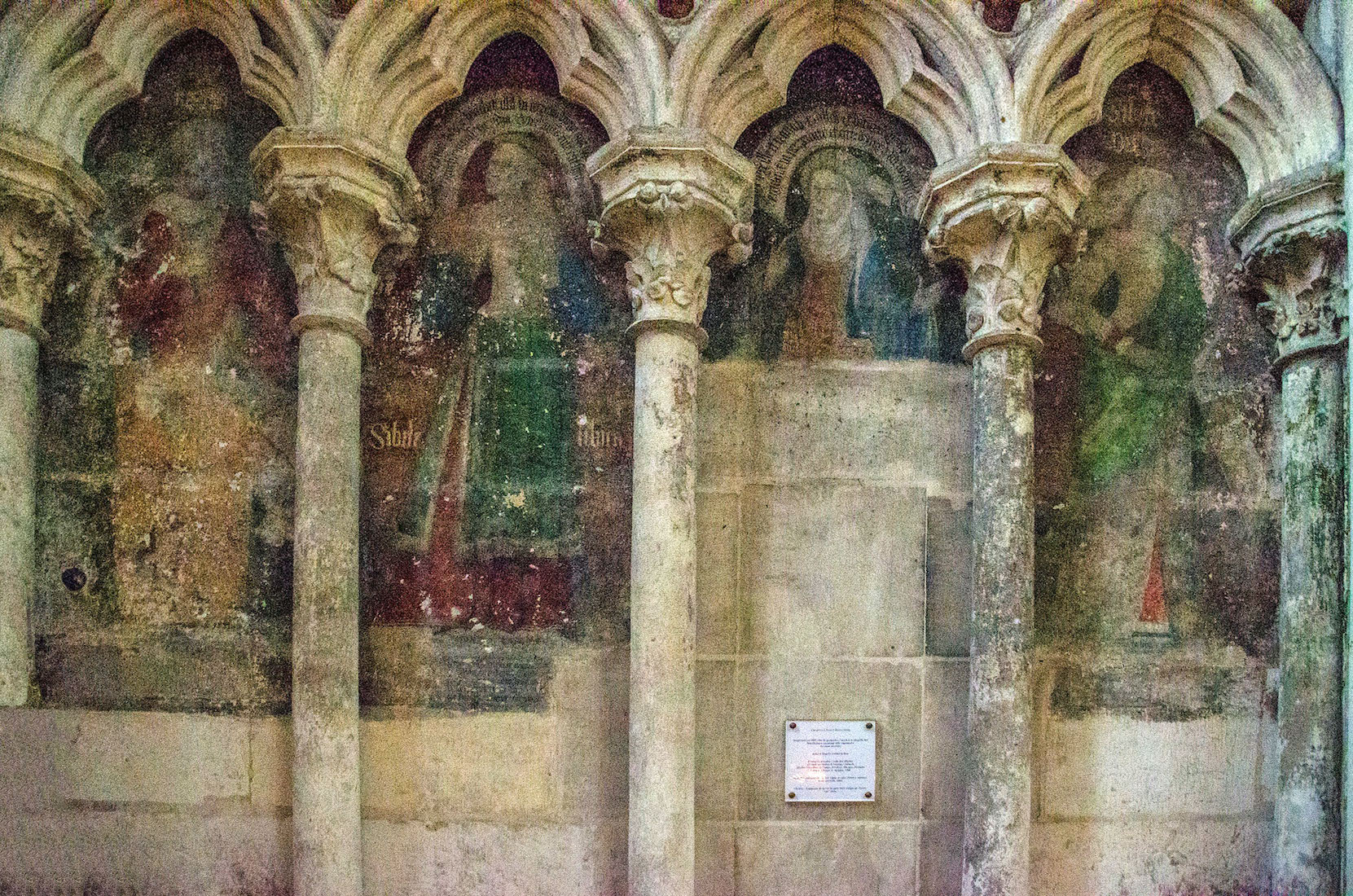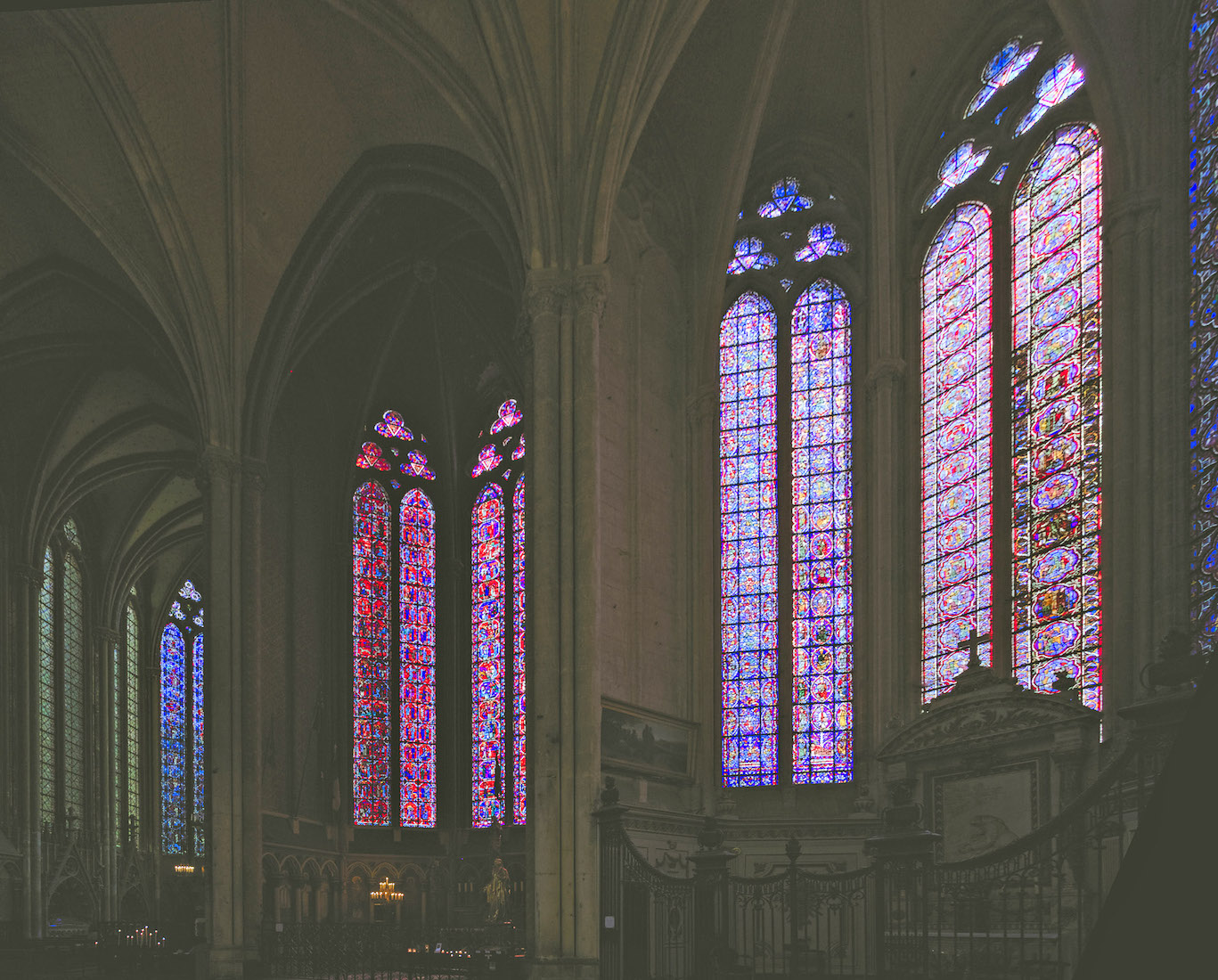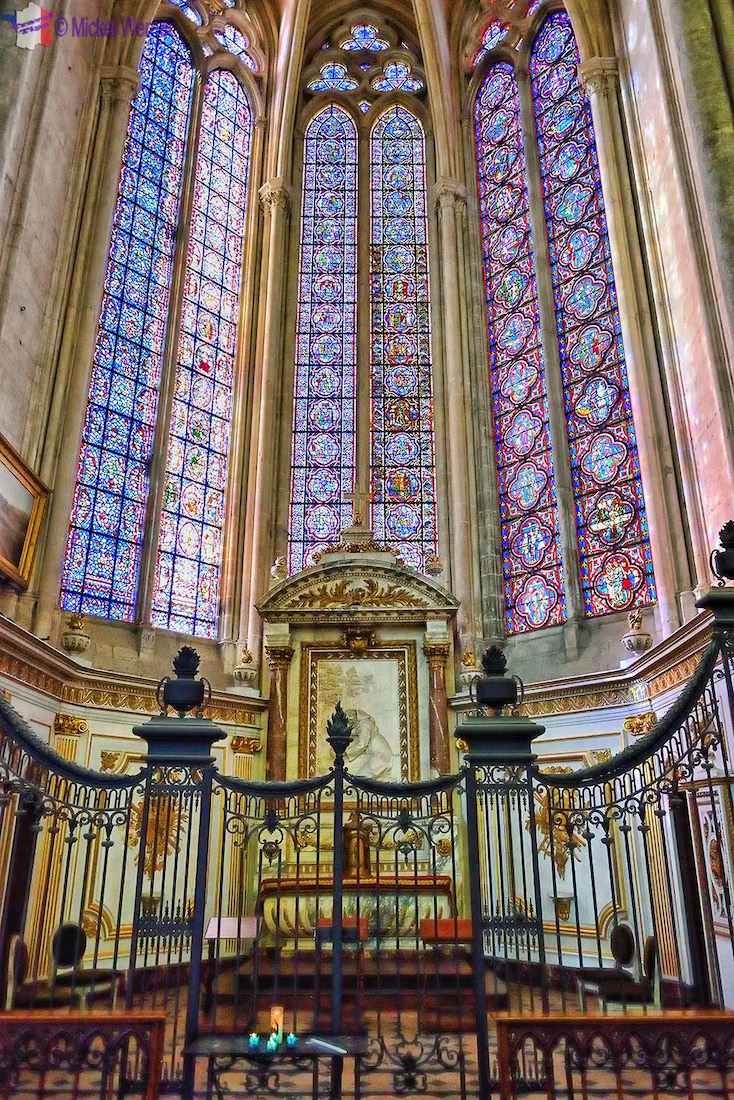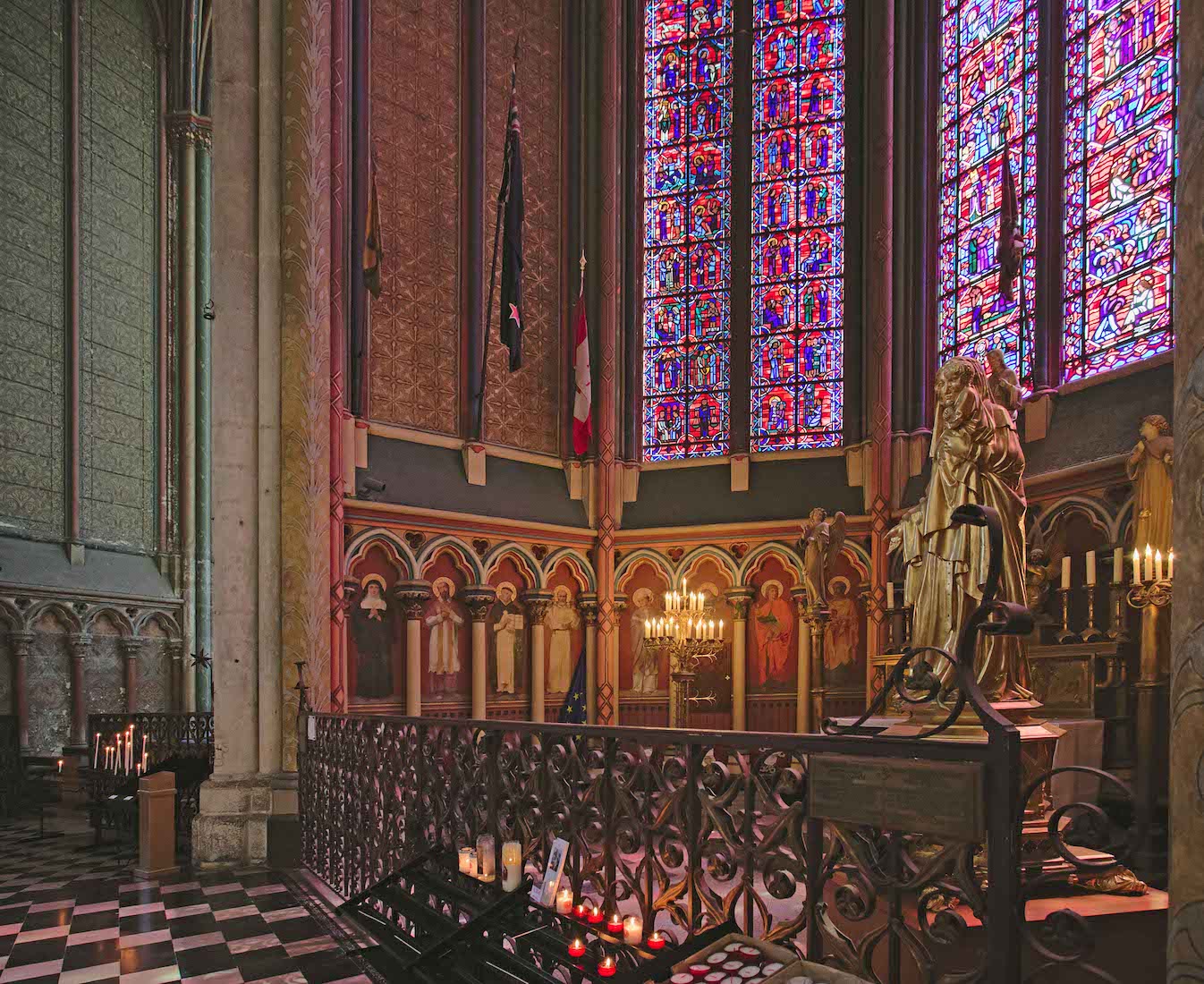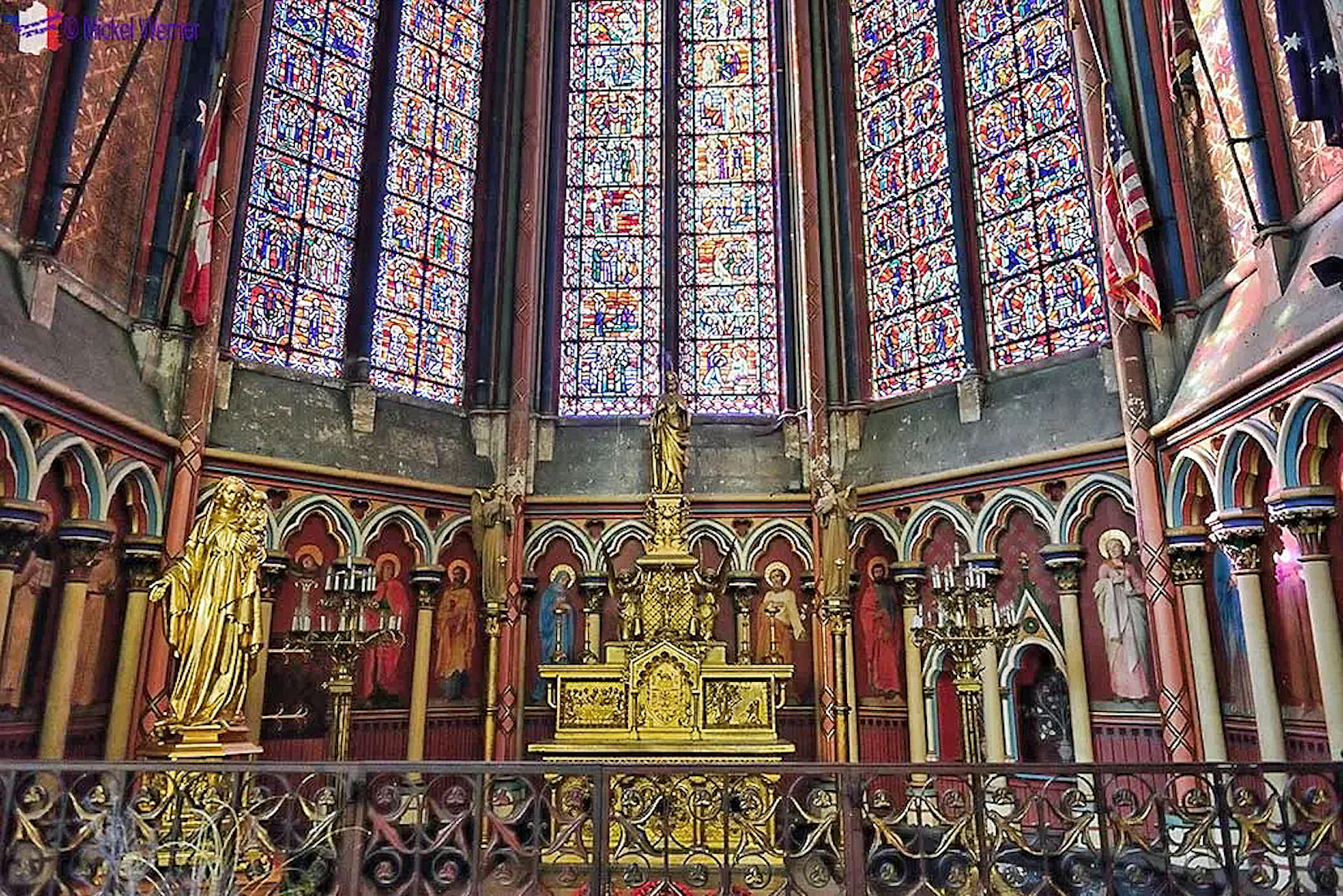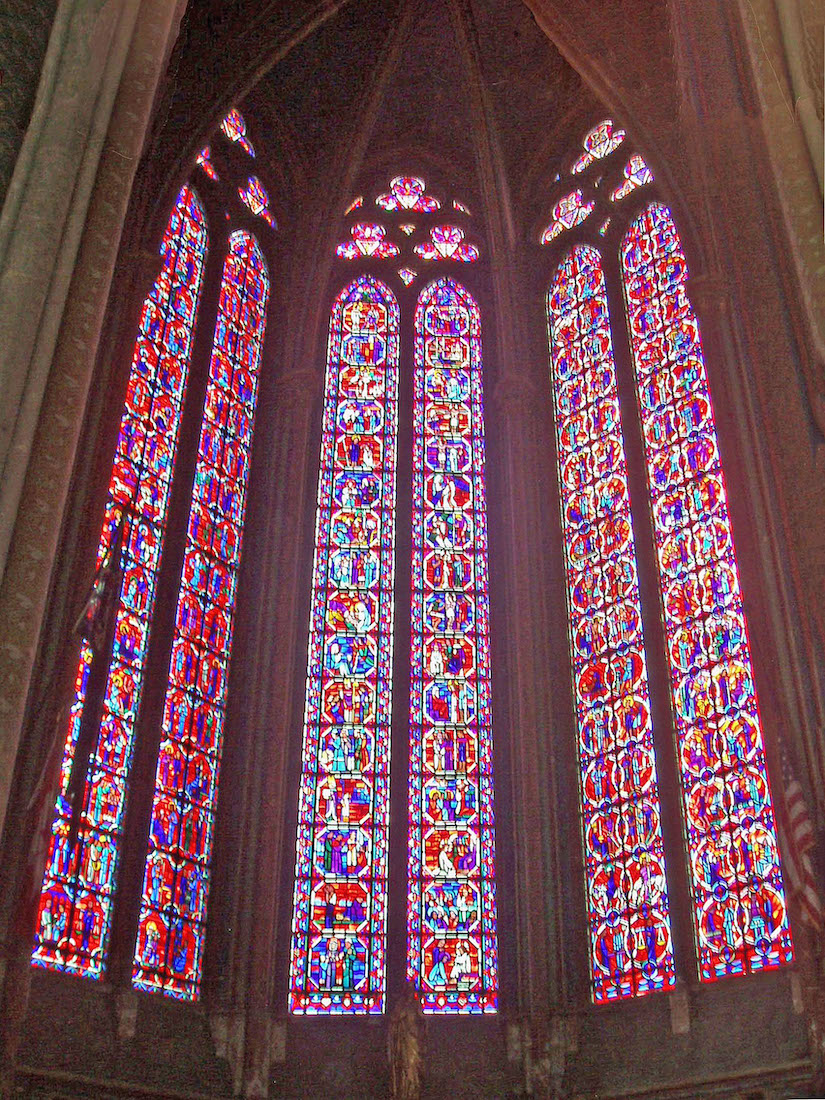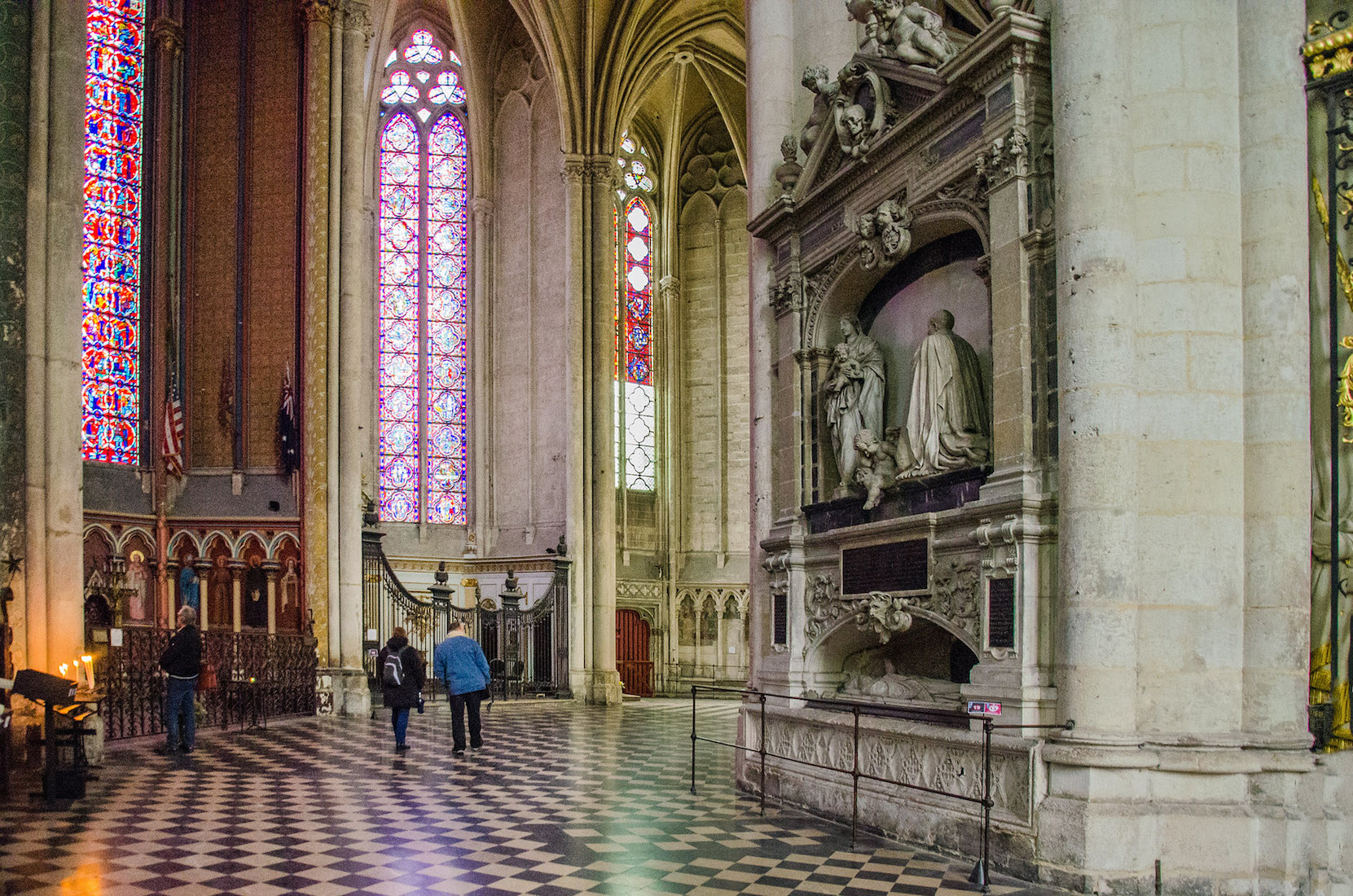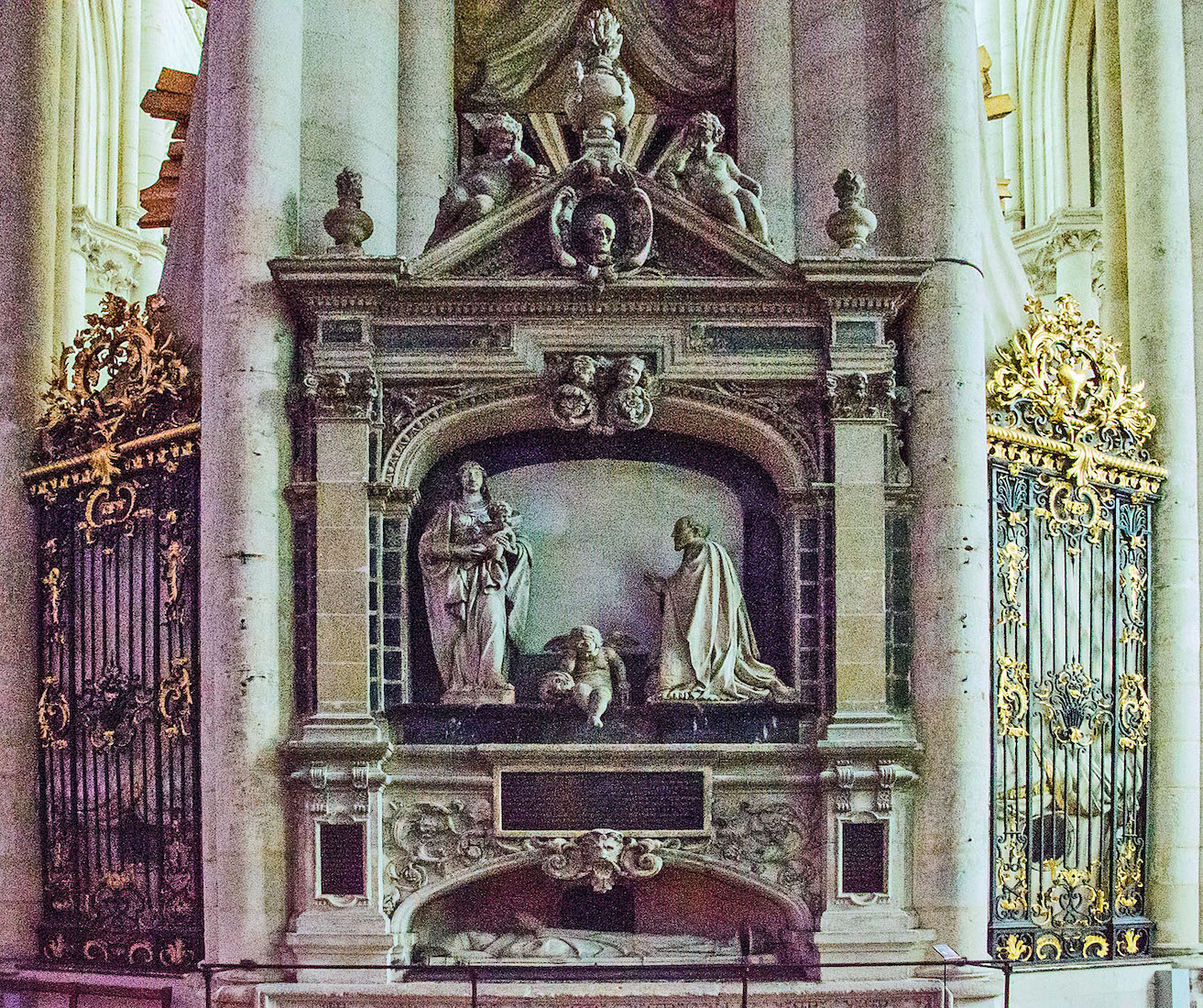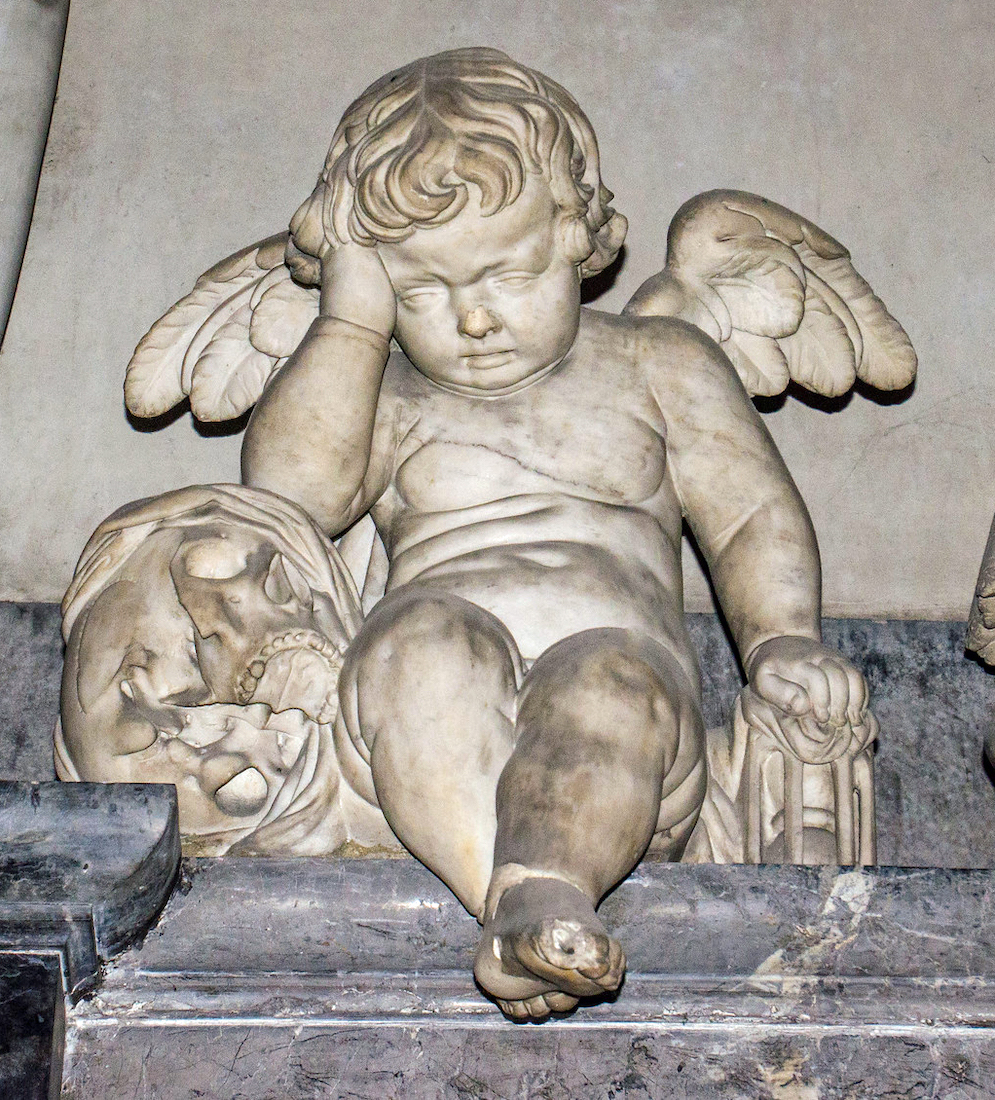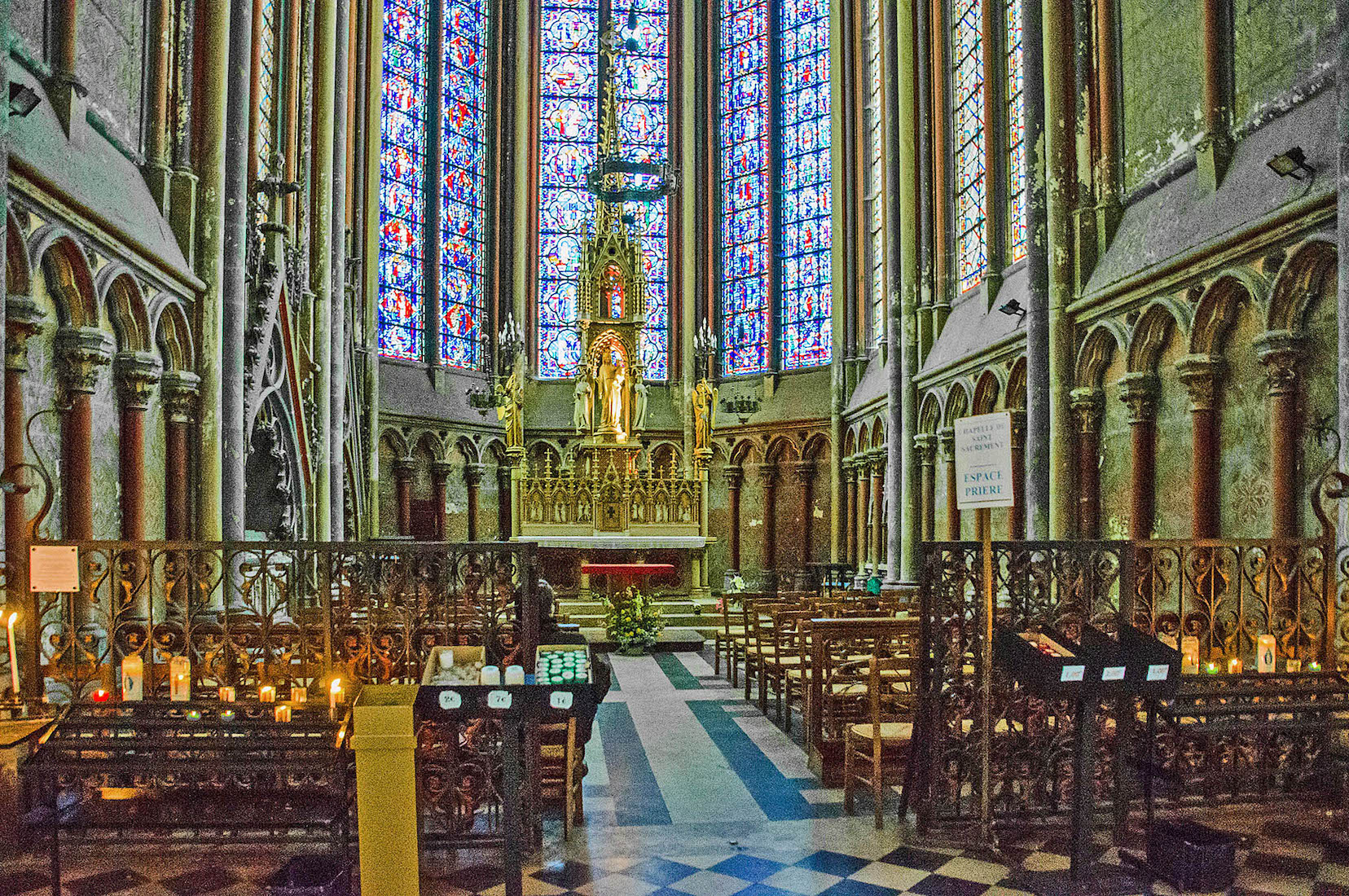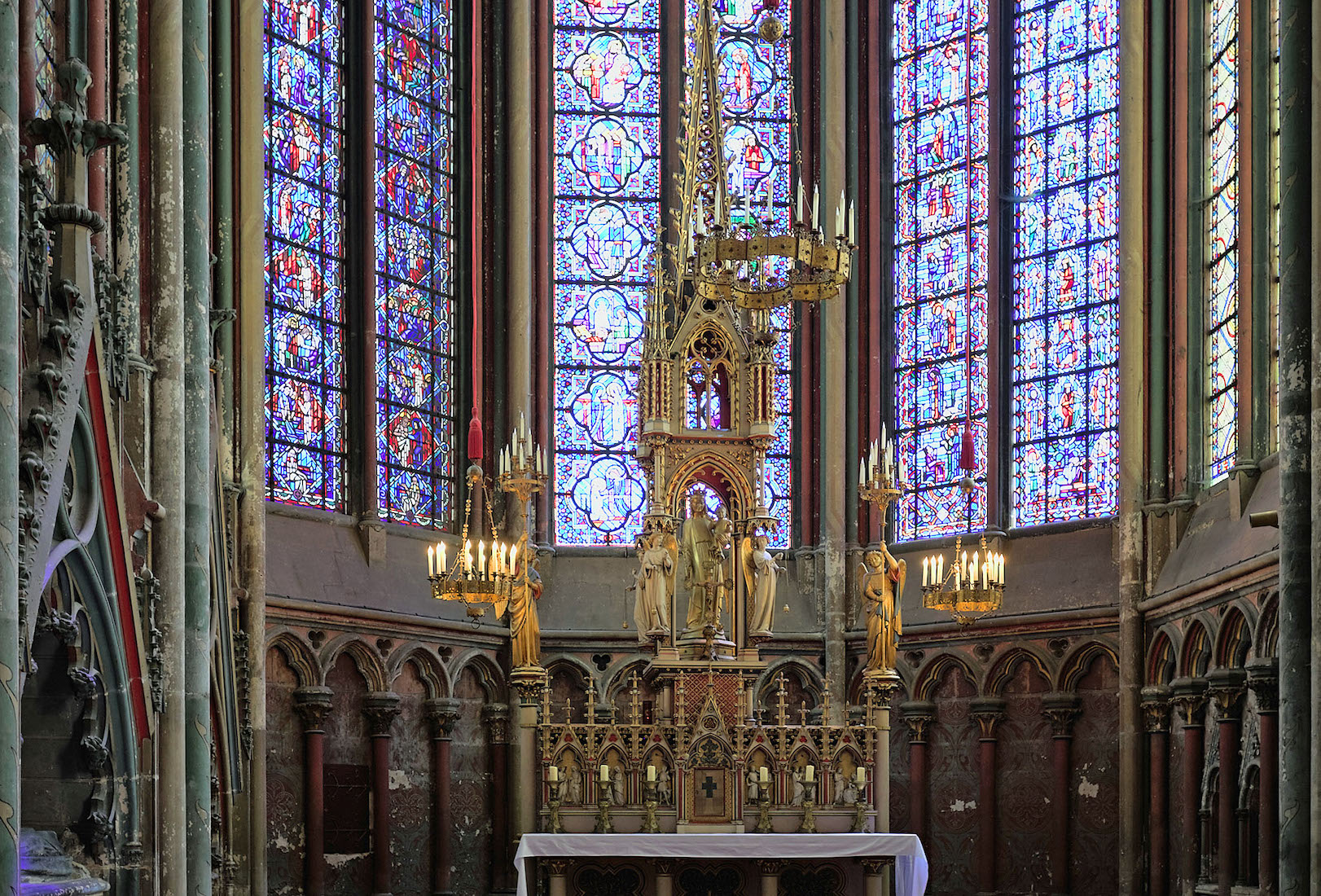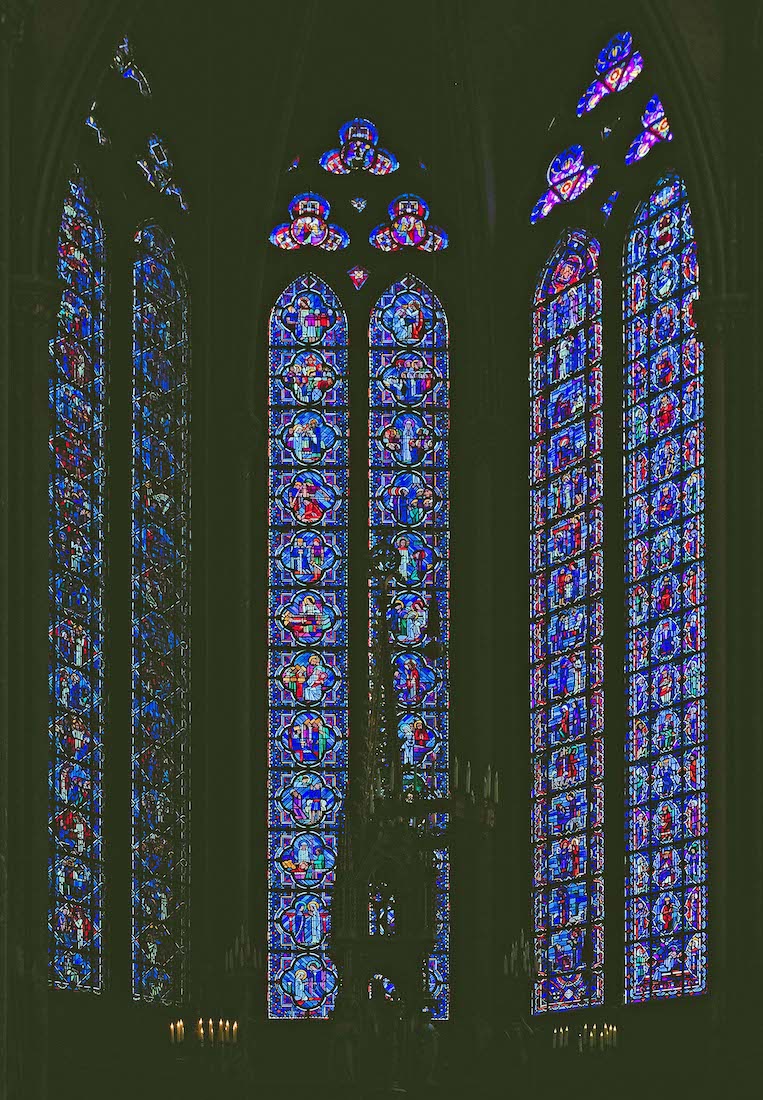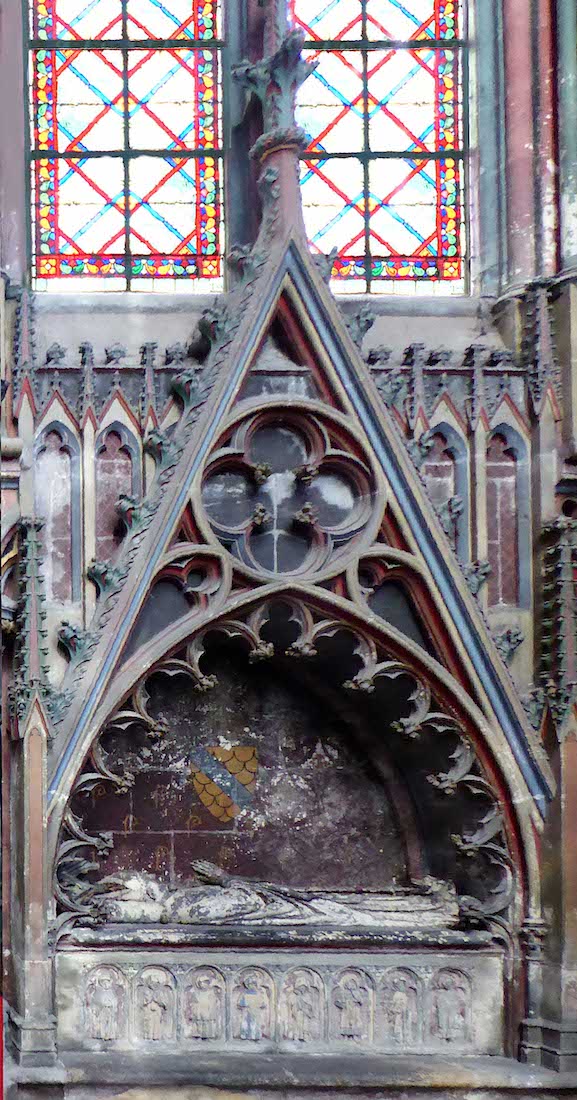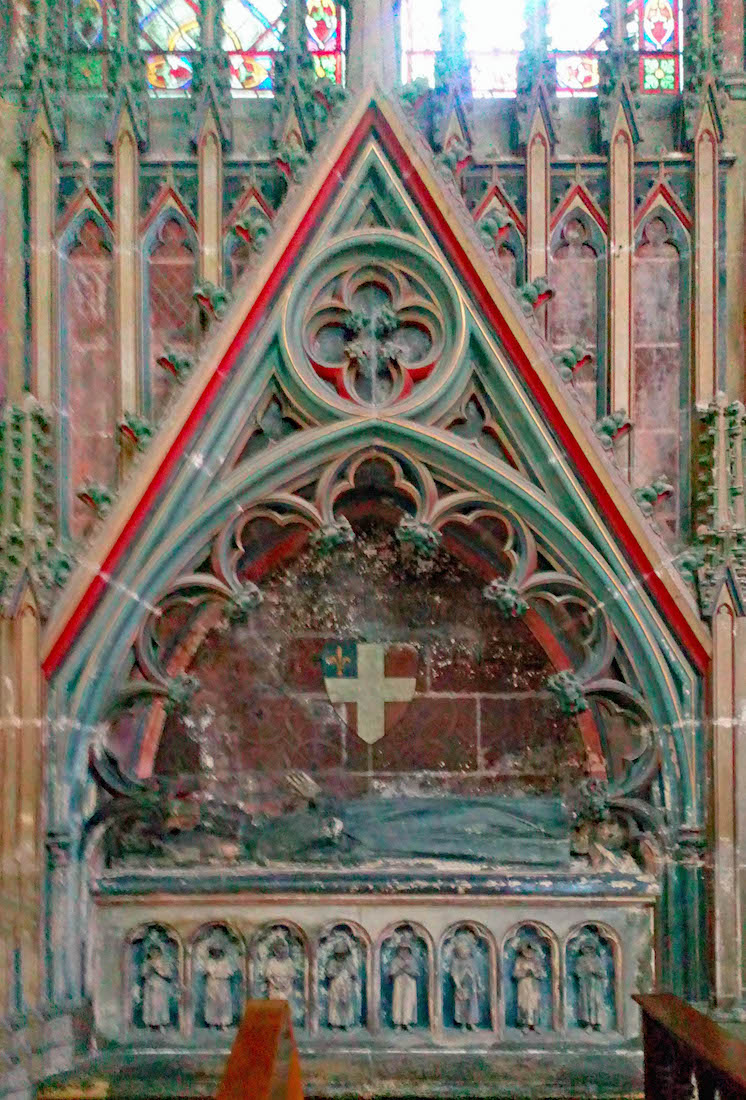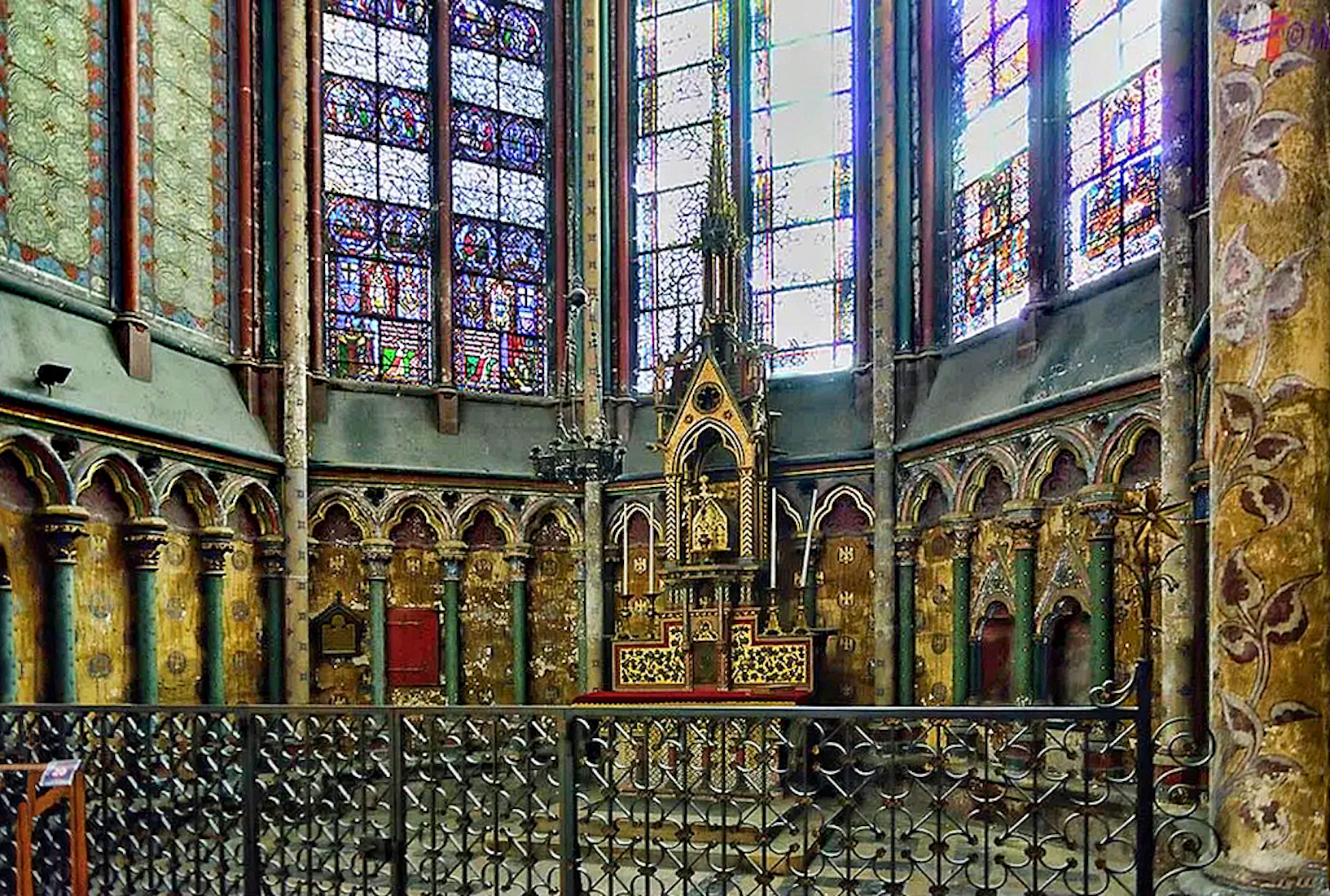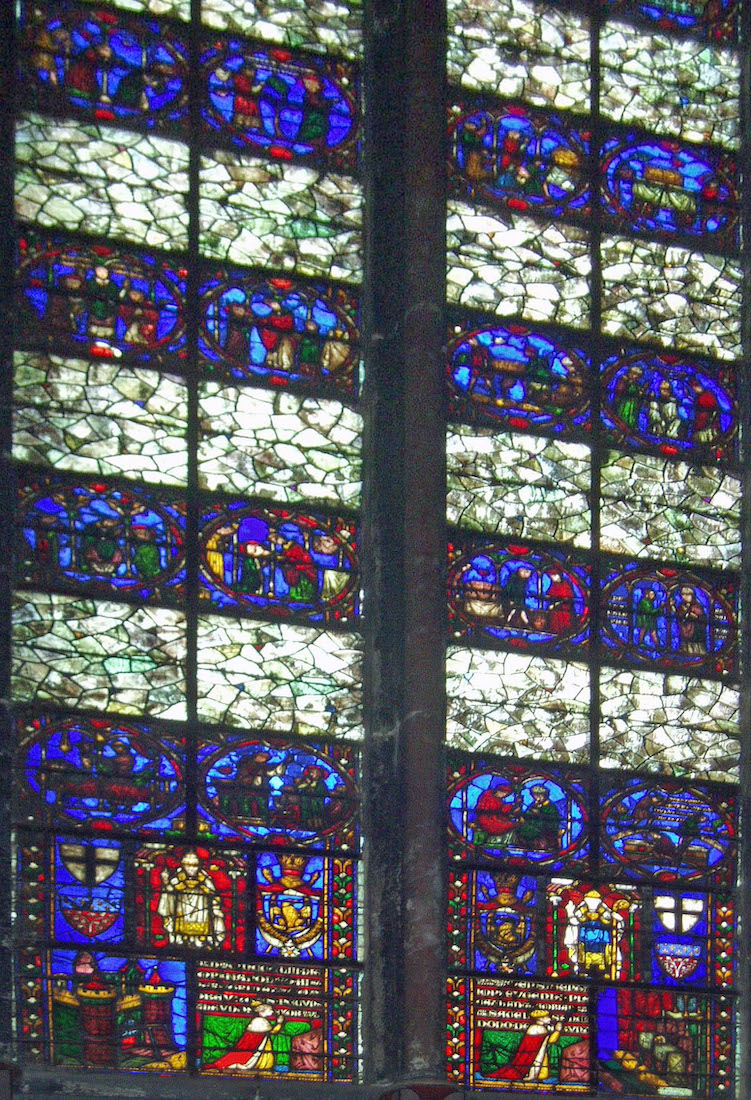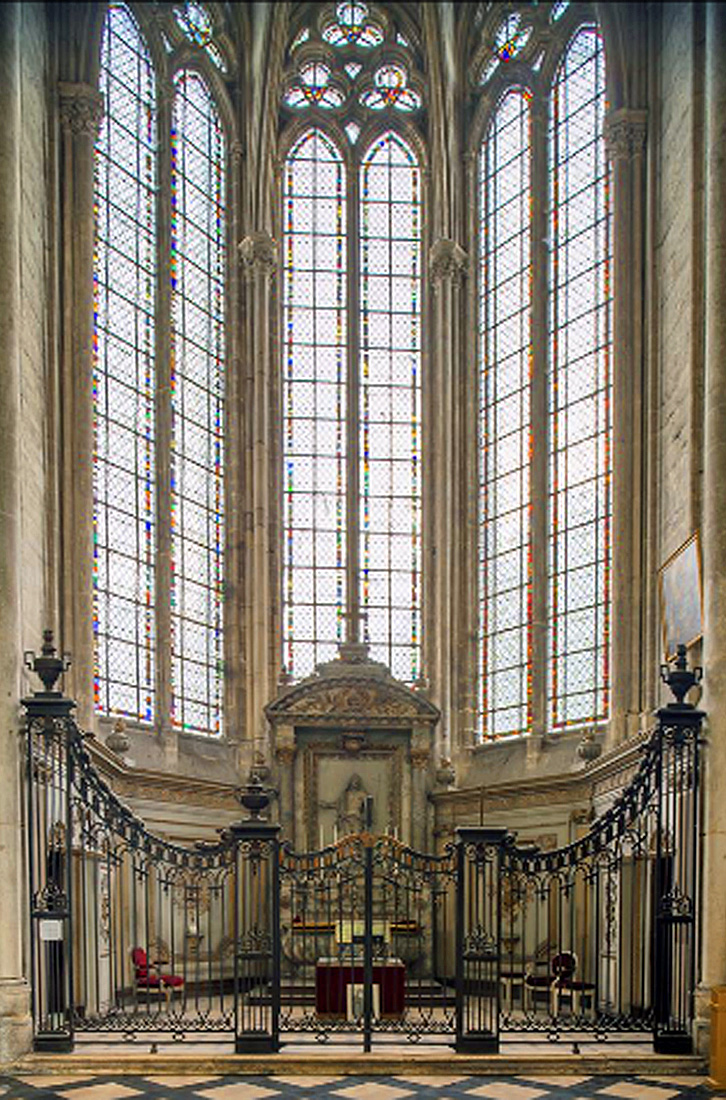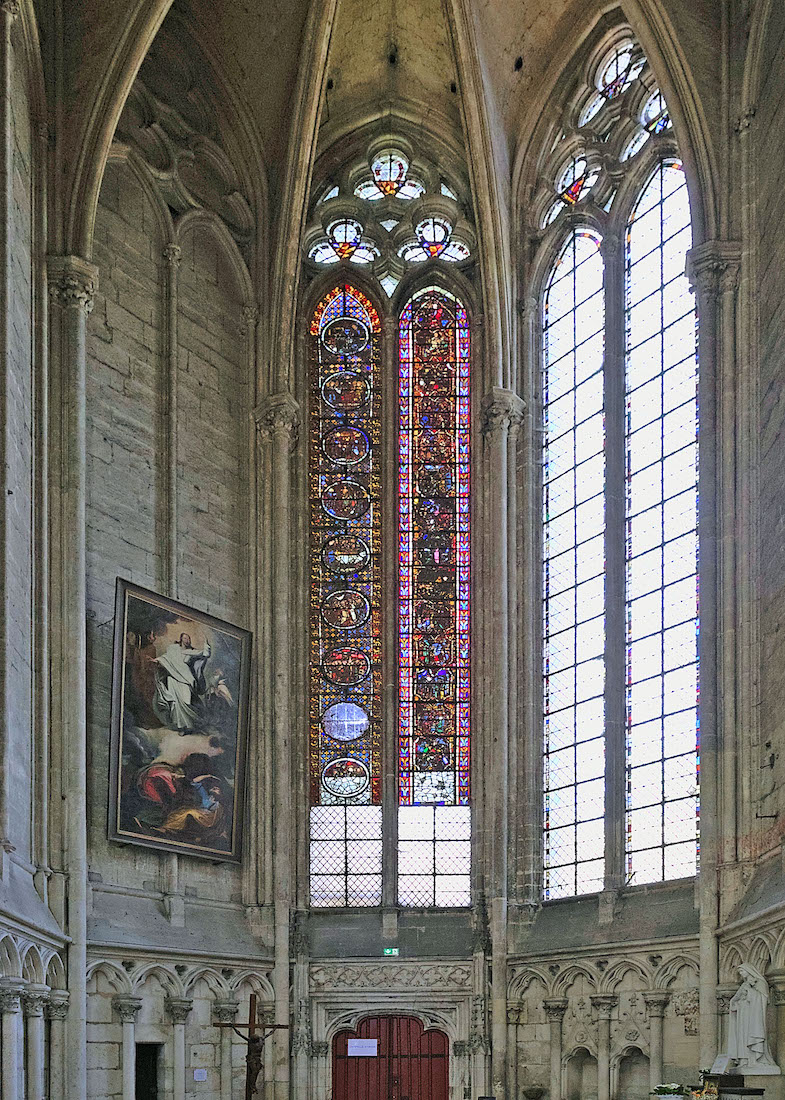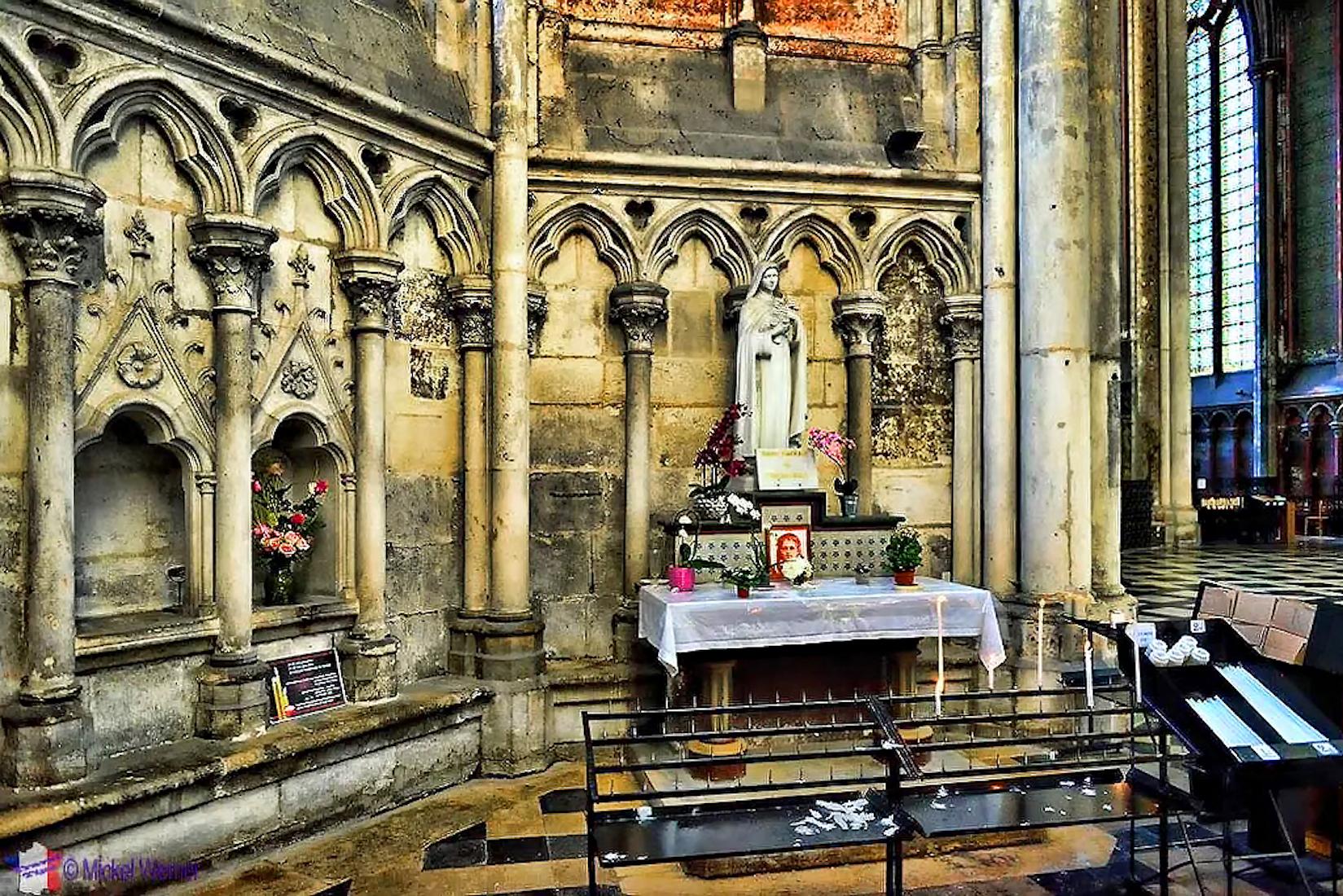AMBULATORY
A1. T0 THE SOUTH AMBULATORY SZ
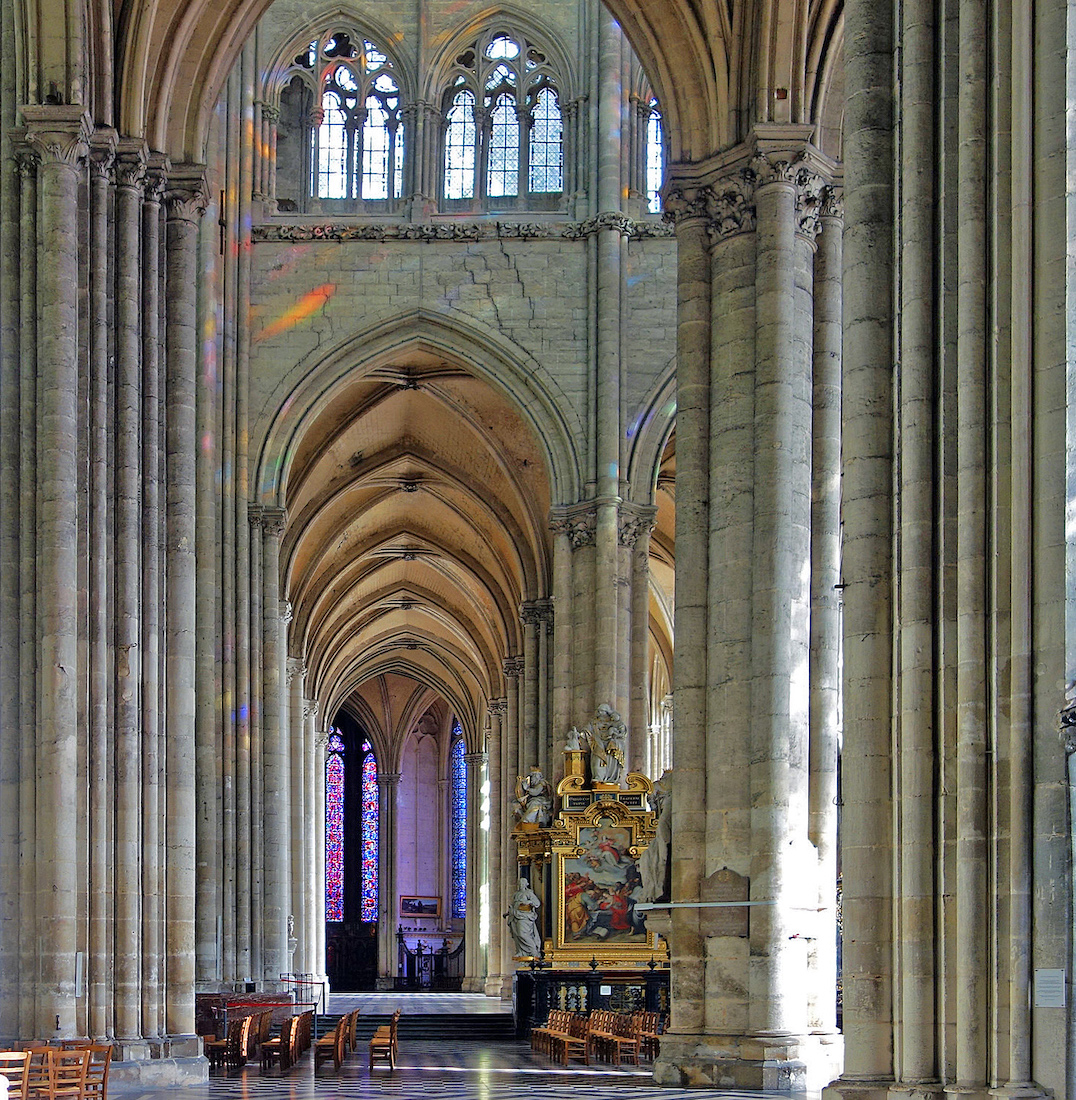
Time now to climb the few steps to the South ambulatory. Immediately to our right is the Chapel of St Peter and St Paul. (The best view is from the South transept.) INDEX
A2. CHAPEL OF ST PETER AND ST PAUL WC LM
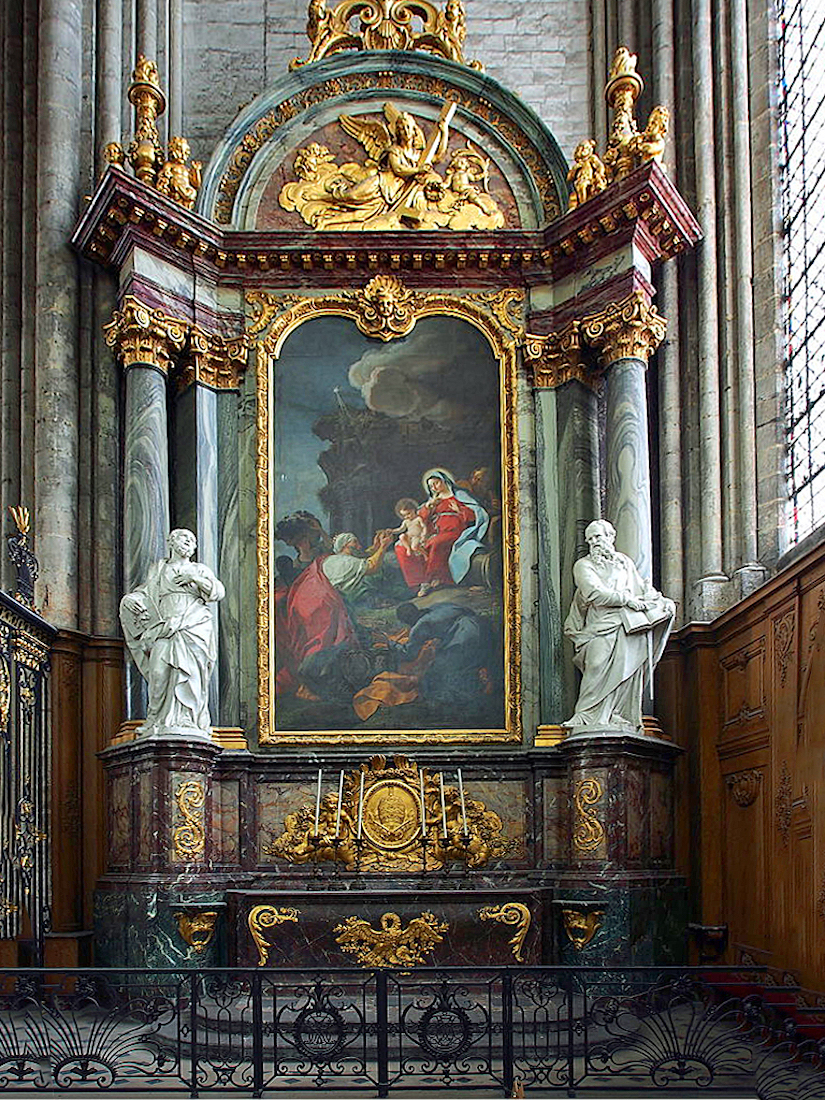
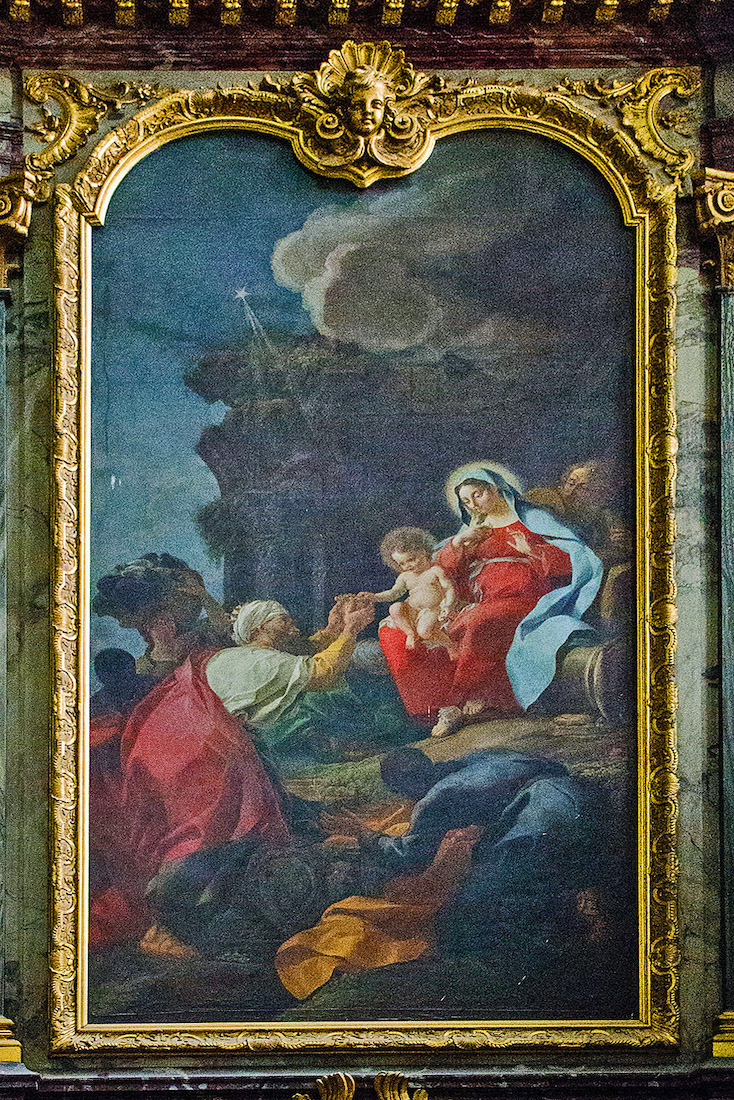
The Chapel of St Peter and St Paul is also known as the Chapel of the Conversion of Saint Paul. It was founded in 1233 by Dean Jean d'Abbeville. To our extreme right, cunningly hidden behind the 18th-century wooden paneling, is the door to a circular staircase leading up inside the Eastern tower of the transept to the triforium level. In passing from the light of the chapel to the darkness of the stairs we mimic the episode of the blindness of Saint Paul. [Photo1 Credit: Wikimedia Commons Fichier]
A3. TOMB OF BISHOP FERRY DE BEAUVOIR WC
After passing the red pillar, the South ambulatory widens. To our right a series of chapels fans out, and to our left a high screen separates the ambulatory from chancel and sanctuary. First on our left is this tomb of Bishop Ferry de Beauvoir. The Bishop had sided with the Burgundians and was forced to flee Amiens when King Louis XI regained control of the city. He was first buried in exile in the church of S-Firmin de Montreuil, but his body was brought back to Amiens by his nephew, Adrien de Hénencourt c.1490 in order to rehabilitate his disgraced uncle. The tomb image of the bishop, in full episcopal gear, was intended to be seen in relation to the image of Saint Firmin arriving in Amiens directly above. [Photo Credit: Wikimedia Commons Ignace-François Bonhommé]
A4. TOMB OF ADRIEN DE HÉNENCOURT CD
Just beyond the Beuvoir tomb is the tomb of Adrien de Henecourt, a nobleman and religious figure involved in the Cathedral’s life from 1490 to 1529. Above the tomb are scenes from the life of St Firmin.
A5. ST JOSEPH CHAPEL WC
A little further along the ambulatory we come to the Chapel of St Joseph on the South side. There is a pleasing statue of Joseph holding the young child Jesus. This space was put to use as a chapel soon after construction, as indicated by the piscina set into the outer wall. It was known as the Chapel of Notre-Dame Anglette (Beata Maria Anglice) perhaps derived from angulus, corner, or suggesting an English connection. Perhaps Eleanor of Castille was involved in the foundation. The space was closed in with a screen and the community of chaplains kept their archive here. [Photo Credit: Wikimedia Commons Txllxt]
A6. SOUTH CHOIR AISLE AMT WC
We continue our walk up the South choir aisle. The aisle itself is spacious, and on our right are various chapels with large colourful stained glass windows. The floor is paved with black and white tessellating patterns of tiles.
A7. ST ELOI’S CHAPEL CU WC LM
The next chapel on our right is St Eloi’s Chapel. Amiens cathedral possessed a relic of St Eloi, the famous bishop of Noyon, and the chapel of St. Eloi was first documented 1243 with foundation of a chaplaincy. The feast of the translation of the relic took place each year on June 25 with a station in the chapel at Vespers. One of the windows contains some stained glass, and there are some old frescoes visible on the wall at right. The barricaded doorway leads through to the external sacristy. [Photo Credits: Photo1 Columbia University (permission requested); Photo 2 Wikimedia Commons Denis Krieger]
A8. APSE WINDOWS CD
The windows of the choir aisle are overwhelming. We arrive at the St Nicaise Chapel with its special monument.
A9. ST NICAISE’ CHAPEL MW
The dedication to Saint Nicaise, legendary archbishop of Reims, indicates the dependence of Amiens upon the metropolitan church of the province of Reims. In 1340 Guillaume d'Espinoy (d.1343), chaplain of the cathedral, founded a chaplaincy of Saint Nicaise. He also donated a relic of that saint and a window The tall windows give a blaze of light and colour to this chapel.
A10. ST JAMES’ CHAPEL CD MW
There had been an altar dedicated to James and John in the cathedralthat burned in 1218. James was the patron saint of the local corporation of haberdashers who had their headquarters in this chapel and were originally represented in a window. In 1253 Laurent de Montreuil, penetencier, founded three chaplaincies here. Viollet[de-Duc designed the furniture and decoration of the Chapel, including the gilded bronze altar. The Chapel contains a large brass statue of the Madonna and Child.
A11. CHAPEL WINDOWS AND PLAQUE AMT LM
St James’ Chapel also serves as a war memorial with the flags of the World War I allied powers and memorial wreaths.
A12. SOUTH AMBULATORY AND TOMB LM
We are now standing at the Eastern end of the ambulatory with the chapels of St James, St Nicaise and St Elois before us. To our right is a monument which backs on to the high altar in the sanctuary.
A13. MONUMENT BEHIND THE HIGH ALTAR LM LM
The monument directly behind the high altar is regularly called ‘L’Ange qui Pleure’ (the crying angel). However, the monument by Nicolas Blasset, is dedicated to canon Guilain Lucas (died 1628). The canon kneels and prays towards the Madonna and Child, and in the centre of the monument is the figure of a weeping angel with one hand and elbow resting on a skull. This figure became very popular as postcard during WWI..
A14. LADY CHAPEL LM
The Lucas monument faces directly East to the Lady Chapel (Notre Dame, the Chapel of the Virgin Mary). •• The foundation of the feast of the Conception of the Virgin Mary by canon Pierre d’Eu in 1252 was possibly contemporaneous with the construction of this chapel. In 1259 the chapter ratified the foundation made by Canon Pierre d’Eu of a daily mass of the Holy Virgin Chapel in majori capella nostre ecclesie. The mass was performed by two chaplains before the office of Primes. •• The chapel was designated (1292) as ‘the chapel of the drapers’: the drapers of Amiens had possibly contributed to its construction. It served as the parish church for the inhabitants of the area of the cloister, the parish of Notre-Dame to the South of the Cathedral (1262).
A15. OUR LADY ALTAR CD
In the Lady Chapel there is a towering golden altar-piece behind the altar. At centre is the Virgin Mary holding the Child Jesus, and surrounded by angels. On either side an angel carries a tall candlestick supporting a dozen candles. The Virgin stands in a Gothic arch which supports a tall graceful tower. Over the altar hangs a golden crown with some twenty candles.
A16. LADY CHAPEL WINDOWS CD
Some of the earliest glass, from about 1269, is found in two of the lancets in the high windows of the Chapel at the end of the apse, at the East end of the Cathedral. These two windows depict the same scene, one the inverse of the other. They show a clergyman presenting the stained glass to the Virgin Mary, to whom the Chapel is dedicated. Angels carry crowns which they hold over the heads of the elongated figures. These windows are impressive for their size and deep colour, rather than for their detail. They were made by Alfred Gérente, a Parisian artist who championed the reproduction of Gothic stained glass.
A17. CHAPEL TOMBS WC WC
There are two tombs on the North wall of the Lady Chapel. The tomb shown at left is that of Simon of Gonçans. The tomb at right is that of canon Thomas de Savoie (d1337) with eight carved reliefs of weepers or mourners. We now leave the Lady Chapel and walk back along the North ambulatory. We have mentioned how these chapels have multiple names. It appears that the Lady Chapel with varying nomenclature is now known as The Blessed Sacrament Chapel! [Photo Credits: Wikimedia Commons Pierre André Leclercq & Ybroc]
A18. ST AUGUSTINE’S CHAPEL MW
The first chapel we come to is St Augustine’s Chapel. This chapel was dedicated to Saint Augustine of Canterbury and not the bishop of Hippo. This is indicated by remains of a window depicting the life of the Apostle of England. In 1206 an act of fraternity established links between the canons of Amiens and the monks of Christ Church, Canterbury.
A19. CHAPEL OF ST JOHN THE BAPTIST WC
The hospital (Hôtel Dieu) that had flanked the cathedral was dedicated to the Baptist and it is possible that there had been an ancient baptistery on the site. In 1206 the cathedral received the famous relic of the Saint's head, retrieved from Constantinople. The relic may, at first, have been displayed in this chapel. The chapel of John Baptist was the seat of the confraternity of tanners who held their meetings there and gave a window.
A20. ST QUENTIN’S CHAPEL CD MW
The name Saint-Quentin-des-Meurtris or des Cinq Clercs goes back to 1244 when five clerks were executed on orders of Baillif Geoffroy de Milly, who was condemned to establish six chaplaincies here. Saint Quentin was thought to have been one of the early missionaries who brought Christianity to Amiens and to have been imprisoned in this city


